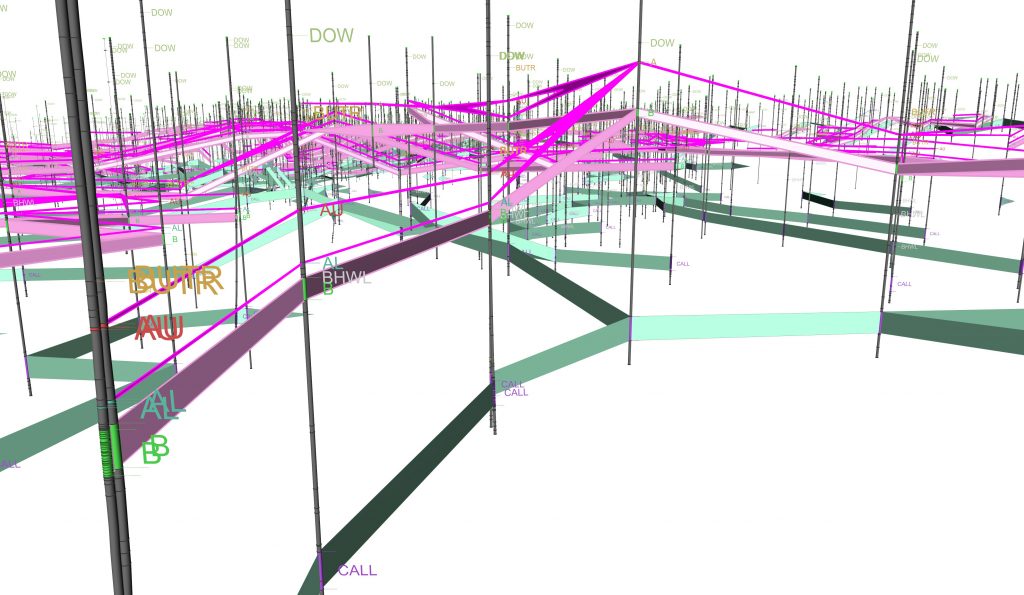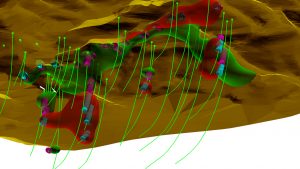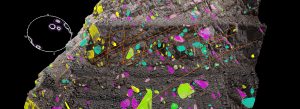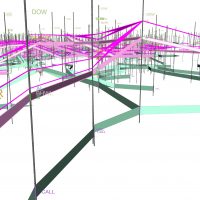Maptek resource modelling technology on show at PDAC
Monday, March 6th, 2017
With the investment stream opening up, visitors to this year’s PDAC in Toronto will be keen to explore resource estimation and project evaluation tools that can add value to mining projects.
Maptek solutions cover the entire mine cycle, from exploration through modelling, mine design, optimisation, production and rehabilitation.
Targeting is easier than ever with Maptek capabilities for handling large datasets. Evaluating multiple prospects on the desktop helps ensure money is not wasted pursuing an uneconomic project. The data remains available and processes are fully auditable and can be revisited when conditions change. Maptek’s latest Eureka 3 allows multi-source, historic datasets to be visualised spatially alongside survey, drillhole, geophysical and other exploration data. Multiple drillhole databases can be loaded simultaneously for viewing, correlation and modelling. Level of detail rendering allows users to easily zoom in to view areas of interest. Section and grid visualisation promotes intuitive analysis of a potential resource. Full interoperability with Vulcan allows analysis, modelling, design and optimisation to proceed in a seamless workflow.
Maptek’s latest Eureka 3 allows multi-source, historic datasets to be visualised spatially alongside survey, drillhole, geophysical and other exploration data. Multiple drillhole databases can be loaded simultaneously for viewing, correlation and modelling. Level of detail rendering allows users to easily zoom in to view areas of interest. Section and grid visualisation promotes intuitive analysis of a potential resource. Full interoperability with Vulcan allows analysis, modelling, design and optimisation to proceed in a seamless workflow.
 Vulcan implicit modelling tools provide RBF and uncertainty modelling regimes for working with complex geological domains. Users can maximise the use of all historical, drilling and assay data to run different scenarios for efficiently assessing the potential grade and tonnage of a resource. Sub-blocking allows accurate modelling of geological contacts and boundaries, and users can modify solids in freehand mode by pinching, smoothing and cutting to better represent geological interpretation.
Vulcan implicit modelling tools provide RBF and uncertainty modelling regimes for working with complex geological domains. Users can maximise the use of all historical, drilling and assay data to run different scenarios for efficiently assessing the potential grade and tonnage of a resource. Sub-blocking allows accurate modelling of geological contacts and boundaries, and users can modify solids in freehand mode by pinching, smoothing and cutting to better represent geological interpretation.
Geostatistical tools based on GSLIB provide diverse functions for calculating and modelling variograms, including 3D variogram maps and interactive modelling. Conditional simulation allows uncertainties in grade estimation to be quantified and analysed, providing a picture of the robustness of the deposit. Knowing both the grade of a deposit and the likelihood that the grade estimate is correct allows for much better decision-making.
At the mine planning stage, rapid pit design techniques allow evaluation of multiple parameters and scenarios to make the best  decisions going forward. Underground stope optimisation and the integrated Gantt scheduler allow users to perform a quick desktop study of the deposit. Flexible optimisation routines are tailored to your site.
decisions going forward. Underground stope optimisation and the integrated Gantt scheduler allow users to perform a quick desktop study of the deposit. Flexible optimisation routines are tailored to your site.
Animation, simulation and interactive 3D PDFs allow timely sharing of data between planners, management and other stakeholders to aid strategic decision making.
Geotechnical considerations can make or break a mine plan. Detailed I-Site laser scan data and intuitive software provide an unbeatable combination for assessing geotechnical risk. Streamlined analysis reduces the gap between data collection and geotechnical deliverables.
All these solutions and more are on show at Booth #1039 PDAC 2017.



 Vulcan implicit modelling tools provide RBF and uncertainty modelling regimes for working with complex geological domains. Users can maximise the use of all historical, drilling and assay data to run different scenarios for efficiently assessing the potential grade and tonnage of a resource. Sub-blocking allows accurate modelling of geological contacts and boundaries, and users can modify solids in freehand mode by pinching, smoothing and cutting to better represent geological interpretation.
Vulcan implicit modelling tools provide RBF and uncertainty modelling regimes for working with complex geological domains. Users can maximise the use of all historical, drilling and assay data to run different scenarios for efficiently assessing the potential grade and tonnage of a resource. Sub-blocking allows accurate modelling of geological contacts and boundaries, and users can modify solids in freehand mode by pinching, smoothing and cutting to better represent geological interpretation. decisions going forward. Underground stope optimisation and the integrated Gantt scheduler allow users to perform a quick desktop study of the deposit. Flexible optimisation routines are tailored to your site.
decisions going forward. Underground stope optimisation and the integrated Gantt scheduler allow users to perform a quick desktop study of the deposit. Flexible optimisation routines are tailored to your site.